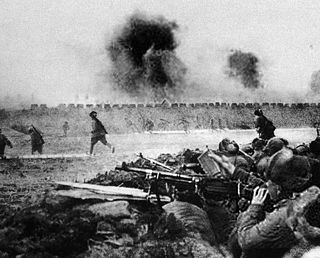 W
WThe Battle of Chishui River (赤水战役), more widely known as The Four Crossings of Chishui River or Crossing the Chishui River Four Times (四渡赤水) in Mainland China, was a major battle between the Chinese Communist Party (CCP) and the Nationalist Party (KMT) during the Long March in 1935. It was the first major battle commanded by Mao Zedong during the Long March, and it is regarded as one of the most representative battles under Mao's command. This battle was a turning point in the first phase of Chinese Civil War. The Chinese Red Army jumped out of the encirclement of Kuomintang by unexpectedly crossing the Chishui River four times, and eventually survived the "crackdown campaign" of Chiang Kai-Shek.
 W
WThe Battle of Kuningtou or Battle of Guningtou (Chinese: 古寧頭之役; pinyin: Gǔníngtóu zhī yì; Wade–Giles: Ku3-ning2-t’ou2 chih1 i4), also known as the Battle of Kinmen (金門戰役; Jīnmén Zhànyì), was a battle fought over Kinmen in the Taiwan Strait during the Chinese Civil War in 1949. The failure of the Communists to take the island left it in the hands of the Kuomintang (Nationalists) and crushed their chances of taking Taiwan to destroy the Nationalists completely in the war.
 W
WBattle of Jinzhou was a battle between the People's Liberation Army and the National Revolutionary Army during the Liaoshen Campaign in the Chinese Civil War. The battle was a turning point in the campaign, which eventually led to capture of Northeast China by the Communist Party.
 W
WThe Battle of Luding Bridge of 1935 was a controversial crossing of the Luding Bridge by the soldiers of the Fourth Regiment of the Chinese Workers and Peasants' Army during the Long March. The bridge, situated over the Dadu River in Luding County, Garzê Tibetan Autonomous Prefecture, Sichuan, China, was located about 80 kilometers west of the city of Ya'an and was a river crossing vital to the Red Army.
 W
WThe Shanghai Campaign was a series of battles fought between the nationalists and the communists for the control of Shanghai, the largest city in China in the latter stage of the Chinese Civil War, and resulted in the city being taken over by the communists, who enjoyed numerical superiority.
 W
WThe Battle of Siping (四平战斗), also known as the Battle to Liberate Siping (四平解放战), was a battle fought between the Communist forces and the Nationalist forces in Jilin, China for the control of Siping during the Chinese Civil War. It took place immediately after the Soviet Red Army withdrew from Siping in March 1946, and resulted in a Communist victory.
 W
WThe Battle of Tashan was a battle during the Chinese Civil War fought in the western part of Northeast China, between forces of the Kuomintang National Revolutionary Army (NRA) and the communist People's Liberation Army (PLA), and resulted in a PLA victory. The battle was critical in determining the outcome of the Battle of Jinzhou and, consequently, that of the entire Liaoshen Campaign. The battle is more commonly known as the blocking battle at Tashan, and is widely regarded by the communists as the first of the three most crucial blocking operations during the Chinese Civil War.
 W
WAfter World War II, Hu Zongnan battled the Communist Party of China and in the early stage of the struggle, was successful in the Battle of Yan'an capturing Yan'an, the capital of the communist base in Shaanxi.
 W
WThe Battle of Yijiangshan Islands was a conflict between forces of the National Revolutionary Army (NRA) of the Republic of China and the People's Liberation Army (PLA) of the People's Republic of China, over one of the last strongholds of Nationalist (ROC) forces near mainland China on the Yijiangshan Islands. The conflict occurred from January 18 to January 20, 1955 during the First Taiwan Strait Crisis, and resulted in a PLA victory and the complete destruction of the ROC garrison.